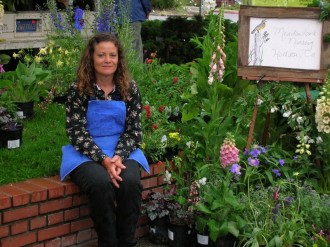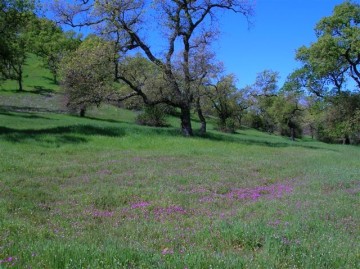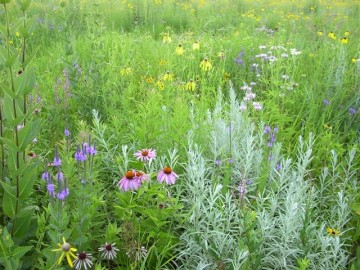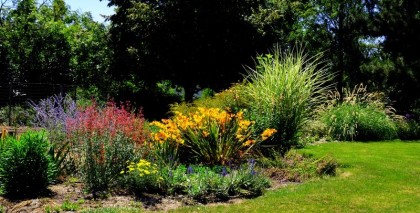About Us
Meadowlark owner-manager Claire Steede-Butler, a native of the Upper Peninsula of Michigan, began her California career by designing with and incorporating eastern woodland perennials into her own landscape installations. She has always loved how her favorites would mysteriously disappear under a carpet of snow in winter, only to re-emerge in spring for a glorious summer display, and she thought that her clients would also enjoy seeing them in their gardens, since many are transplants to California themselves.
In 1982 she started the nursery in her backyard in Redwood City to supply herself with material for these installations. In those days, perennials were hard to come by since very few growers produced them. In 1989 she moved the nursery to its present location 6 miles north of Hollister and nestled it into the foothills of the Diablo Range. The property hosts all the extremes of northern California climate, from hot and sunny days with ocean-driven summer winds to wet, cold winters with occasional snow. Along with the location, Claire decided to change the name of the nursery which had been previously known as Cottage Gardens, and she settled on "Meadowlark" because the image of this sturdy bird, so prevalent in the surrounding hills, brings to mind its range over the whole of the United States. From mountain to prairie to forest, its lovely song is always a positive harbinger of Spring.
Claire has developed her current plant list through experience. A sometimes-frustrating 25 year battle to maintain several client gardens in a development which allowed only native plantings secured her knowledge of how gardens work in the Bay Area. The plantings she describes were already established, having been installed by the developer a few years before when the properties were first placed on the market. The development's beautiful acreages were located on a sun splashed and windy ridge, and incorporated gorgeous bay views, native oaks and manzanita, and were frequented by a large herd of lovely deer. Upscale homes occupied plots of poorly drained clay and/or thin and rocky soils. Coastal plants were struggling in clay soil and riparian species were parched among the sun-baked rocks! Claire had her work cut out for her. Armed with her mom's determination and her own philosophy that nothing gets done without hard work, she dove in.
Well that was then and this is now. A lot has been learned about the use of natives in gardens and successful gardeners now investigate to where plants are adapted before incorporating them into a design. The experience in these native gardens plus subsequent knowledge gained through installation and maintenance of her own designs, nailed down the idea of working with nature and adapting to circumstances, rather than imposing a rigid design on a changeable environment. Serious gardeners know that a garden is not a static entity, learning instead that it is an evolution that develops over time, and often through trial and error.
At Meadowlark we know that many clients want a design which utilizes only evergreen species. Thus more water, fertilizer, pruning and much more maintenance is required to keep their gardens looking good. We also acknowledge that there is an understandable trend toward the planting of native Californian species of plants, since they are "natural" and drought resistant. However, natives must be matched to the particular micro-climate where they thrive, and since there are many micro-climates in California, native gardening requires more knowledge, foresight, soil preparation, and care than other types of plantings. In other words, a native garden is not carefree!
A well-done native planting is a piece of art, and not everyone has the resources and the time to develop one. There are other ways to combat endemic problems in a landscape, such as scarcity of
water, increasingly fluctuating temperature extremes due to climate change, and an overabundance of deer in some areas. In general, perennials require less water since they don't have to be
re-established yearly, are usually very hardy, and are often more showy than native species. There is a perennial solution that is useful for every landscape problem, whether it's poorly drained
soil, deer and pests, or winter cold and summer heat.
With the current trend toward utilizing more water-conserving plants to replace lawns in residential landscapes, the use of perennials and grasses is becoming increasingly more relevant. Creating a meadow, even in a small yard, is not only beautiful and attractive to birds, bees and butterflies it is also more "green" since using lawn mowers, blowers, pesticides, weedkillers and fertilizers is no longer necessary. Air, water, and noise pollution can be decreased by the use of plants that don't require constant feeding, watering, and chemicals. Less work for the homeowner means more time to enjoy the garden! Claire thinks that anyone who has had an opportunity to experience a segment of the true "prairie" - a plot of land that has never been subjected to a plow or any other machine - will never forget the experience. Sensual delights abound: to see, hear and feel the vibrant life it supports is a treat no human should live without. A prairie teems with activity - from beneath the soil level to above in the sky. Micro-organisms in the soil eliminate the need for fertilizer, the dense growth decreases the need for watering, birds bees and butterflies fulfill their destinies and create an eco-system in itself. In essence a prairie, or as is known in the western states a meadow, is a microcosm of nature that humans need and yearn for, but rarely experience in their hectic lives. If a meadow garden is to be your focus, Meadowlark can help you find the right plants.
Many plants that are grown at our nursery go dormant in winter, and while some gardeners may be disappointed, we at Meadowlark are not. We know that deciduous is not a dirty word; rather, we believe it's a good thing! We value the drought resistance and hardiness, the tolerance of clay soil, and the ease of garden maintenance and seasonal interest that deciduous perennials provide. If it's grown at Meadowlark, you can be sure it's tough. The current offerings in the plant list have been developed over the years as tried and true garden plants, fulfilling requirements for drought and deer tolerance, clay adaptability, cold hardiness, low maintenance and beauty. The list is as adaptable as the varieties themselves are, and it expands yearly as new varieties are found to amend difficult situations in the landscape.
Though she retains her landscape contractor's license and oversees garden maintenance for select clients, Claire's main focus at this time is supplying the elite nurseries of the San Francisco Bay Area. Your inquiries regarding the purchase or availability of plant material are welcomed through emails to this site.






